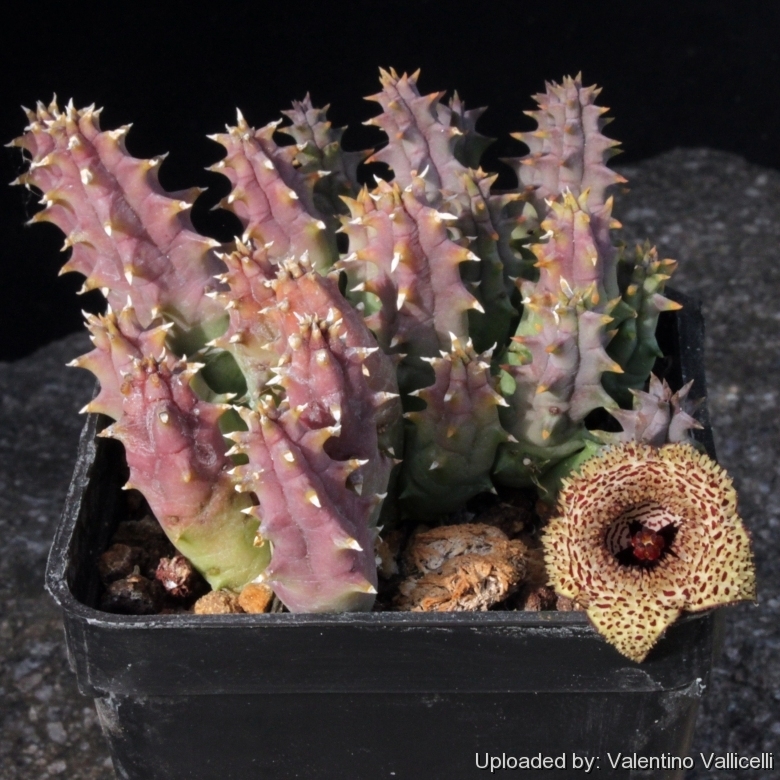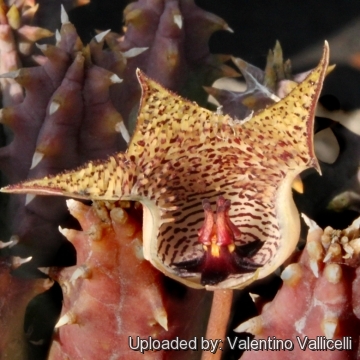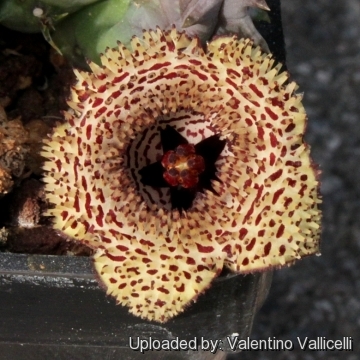Accepted Scientific Name: Huernia hystrix subs. parvula (L.C.Leach) Bruyns
1: 189 (2005)

Huernia hystrix var. parvula (Huernia hystrix subs. parvula) Photo by: Valentino Vallicelli
Origin and Habitat: Huernia hystrixSN|19543]]SN|19543]] subs. parvula is a very small form found only in south-eastern Kwa-Zulu-Natal in Oribi Gorge and Flats.
Habitat and ecology: The species is a good survivor on open rockeries.
Synonyms:
See all synonyms of Huernia hystrix
back
Accepted name in llifle Database:Huernia hystrix (Hook.f.) N.E.Br.Gard. Chron. n.s. 1: 795 (1876)Synonymy: 4
Accepted name in llifle Database:Huernia hystrix subs. parvula (L.C.Leach) Bruyns1: 189 (2005)Synonymy: 2
back
Common Names include:
ENGLISH: Porcupine huernia
Description: Huernia hystrixSN|19543]]SN|19543]] subs. parvula is a distinctive subspecies with much shorter stems rarely more than 3 cm long, and smaller flowers with shorter papillae and the less expanded inner corona-lobes.
Habit: It is a compact plant readily offseting to form low growing dense mats 10 (or more) cm in diameter and up to 3 cm high. The flowers, which arise in succession at the base of the stems, are cup-shaped, with spiny petals, dull yellow in colour and banded with red, but variable.
Stems: Decumbent-erect, spreading, sometimes creeping, usually less that 3 cm long (often longer under cultivation), prominently 5-angled, glabrous, pale green, very slightly glaucous, sometimes tinted with dull purplish. Teeth firm, conical, acute.
Leaves: Rudiments persistent as hard spines.
Flowers: 2–5 together near the base of the stems lying flat on the ground, successively developed much smaller than in other species, with an unusually short corolla tube. Pedicels about 17-18 mm long, glabrous. Buds longer in shape than in subsp. hystrix, conical poited, with a small tooth at each angle. Corolla broad, shortly pointed and when expanded 3-4.5 cm in diameter basally often only weakly roughened. Tube short, campanulate or cup-shaped mouth of the tube and corolla lobes abruptly divaricate. Lobes broadly triangular or deltoid-ovate, occasionally shortly pointed, abruptly and horizontally spreading from the tube, with strongly recurved tips. Inner surface (except within the tube) densely covered with spine-like acute papillae (fleshy processes), but papillae shorter, usually less than 2.5 mm long), fleshy, subulate, sometimes finely pointed, flattened, basally broadened, ochreous-yellow or cream-coloured dotted with crimson spots on the lobes and with numerous transverse crimson lines within the smooth and paler tube. Inner corona-lobes shorter (c. 3.0-3.5 mm in diameter) hoof-like, obtusely clavate, more densely puberulous and tuberculate-furrowed.
Subspecies, varieties, forms and cultivars of plants belonging to the Huernia hystrix group
 Huernia hystrix (Hook.f.) N.E.Br.: has cup-shaped flowers, with spiny petals, dull yellow in colour and banded with red, but variable. Distribution: S-E Zimbabwe, W Mozambique, Swaziland, KwaZulu-Natal and N-E South Africa.
Huernia hystrix (Hook.f.) N.E.Br.: has cup-shaped flowers, with spiny petals, dull yellow in colour and banded with red, but variable. Distribution: S-E Zimbabwe, W Mozambique, Swaziland, KwaZulu-Natal and N-E South Africa. Huernia hystrix subs. parvula (L.C.Leach) Bruyns: has much shorter stems less than 3 cm long, and smaller flowers 3-4.5 cm in diam. Pedicels 17-18 mm long. Distribution: S-E Kwa-Zulu-Natal in Oribi Gorge and Flats.
Huernia hystrix subs. parvula (L.C.Leach) Bruyns: has much shorter stems less than 3 cm long, and smaller flowers 3-4.5 cm in diam. Pedicels 17-18 mm long. Distribution: S-E Kwa-Zulu-Natal in Oribi Gorge and Flats.
Bibliography: Major refrerences and further lectures
1)Doreen Court "Succulent Flora of Southern Africa" CRC Press, 01 June 2000
2) Rob Scott-Shaw "Rare and threatened plants of KwaZulu-Natal and neighbouring regions" KwaZulu-Natal Nature Conservation Service, 1999
3) Focke Albers, Ulrich Meve “Illustrated Handbook of Succulent Plants: Asclepiadaceae” Volume 4 Springer, 2002
4) Walter de Gruyter “Concise Encyclopedia Biology” Walter de Gruyter, 01/gen/1996
5) A.C.White & B.Sloane “Stapelieae” ( White & Sloane) ed. 2 3: 855 Abbey San Encino Press, 1937
6) Luckhoff “The Stapelieae of Southern Africa” Capetown, A.A. Balkema 1952
7) Bruyns, P.V. 2005. “Stapeliads of southern Africa and Madagascar.” Vol. II. Umdaus Press, Hatfield.
8) James Cullen, Sabina G. Knees, H. Suzanne Cubey “The European Garden Flora Flowering Plants: A Manual for the Identification of Plants Cultivated in Europe, Both Out-of-Doors and Under Glass” Cambridge University Press, 11/ago/2011
9) Gideon Smith, Neil R. Crouch “Guide to Succulents of Southern Africa” Struik Nature, 01/November/2009
10) N. E. Brown “Flora Capensis” Vol 4, page 518 1909
 Huernia hystrix var. parvula (Huernia hystrix subs. parvula) Photo by: Valentino Vallicelli
Huernia hystrix var. parvula (Huernia hystrix subs. parvula) Photo by: Valentino Vallicelli Huernia hystrix var. parvula (Huernia hystrix subs. parvula) Photo by: Valentino Vallicelli
Huernia hystrix var. parvula (Huernia hystrix subs. parvula) Photo by: Valentino VallicelliCultivation and Propagation: Very easy to grow, it needs light shade to full sun (but tolerate shadow), very resistant to heat will also tolerate quite cold temperatures but avoid frost, best in a ventilated environment. It is quite resistant to the “Black spot” disease of Asclepiads, Water regularly during the growing season, keep dry in winter. Use a gritty, well-drained soil.
Propagation: It is easily propagated by removing a cutting, sometimes with roots attached, in spring and summer, but seeds germinate readily if they are sown when fresh.












